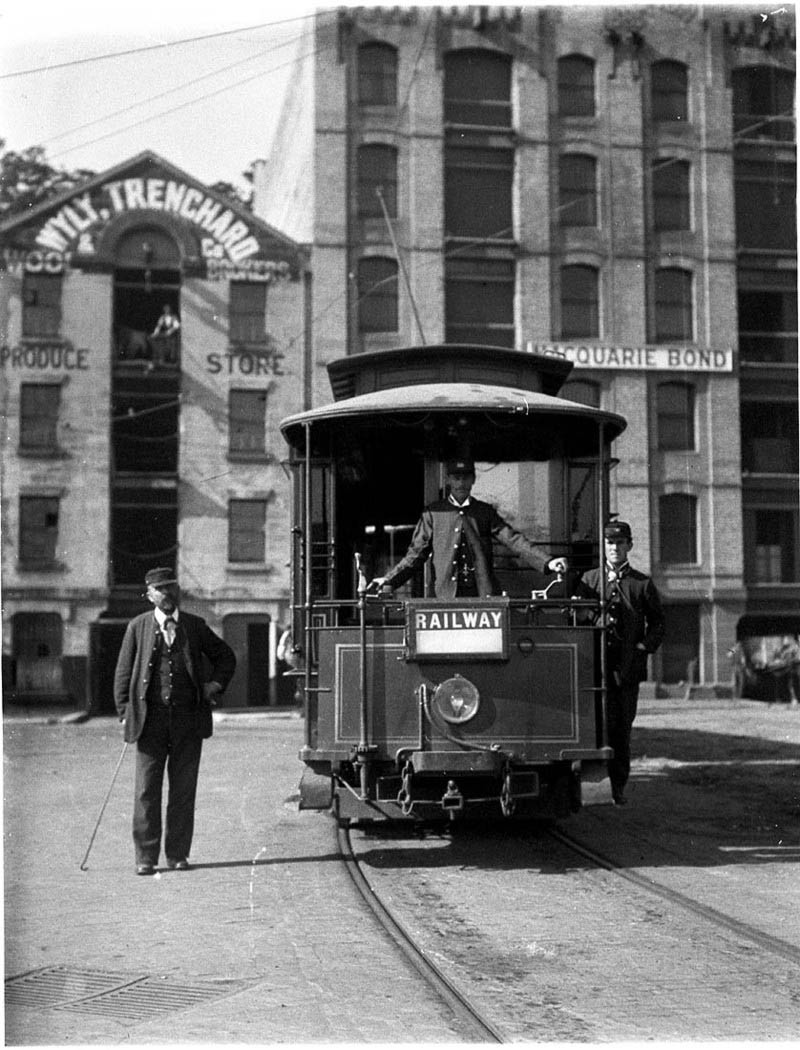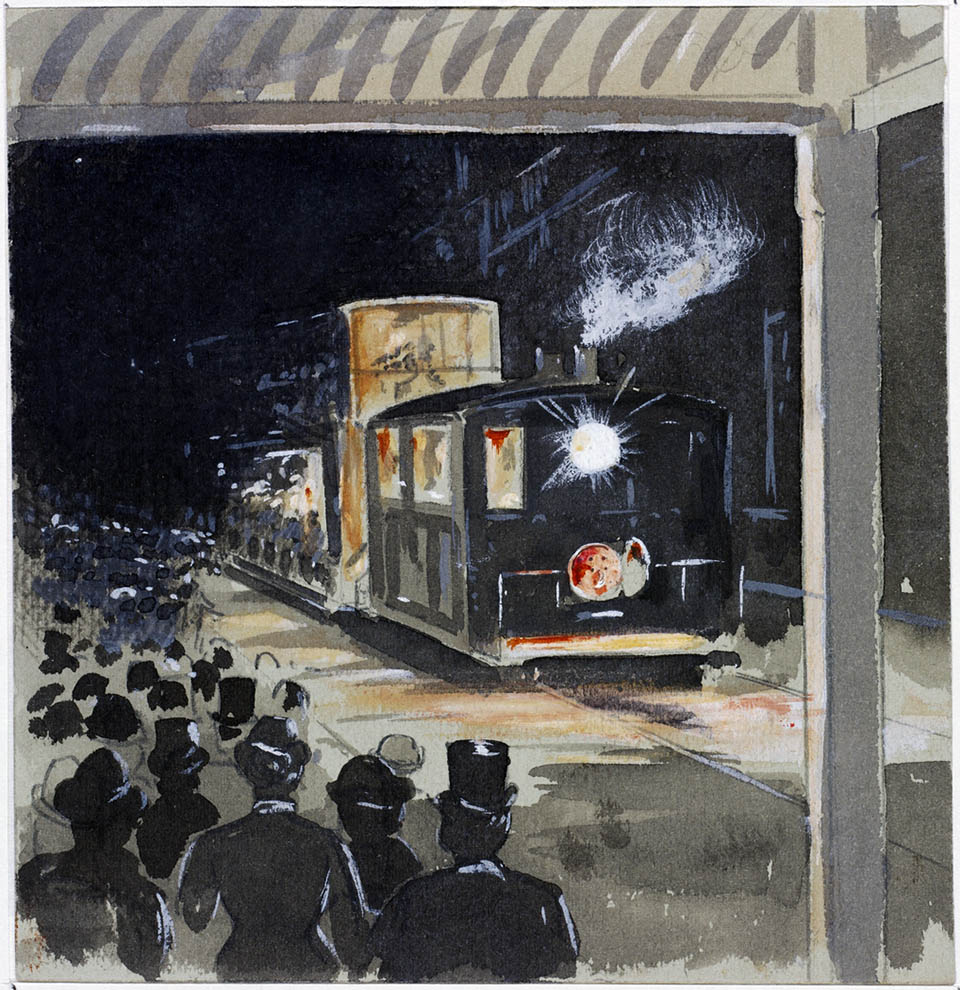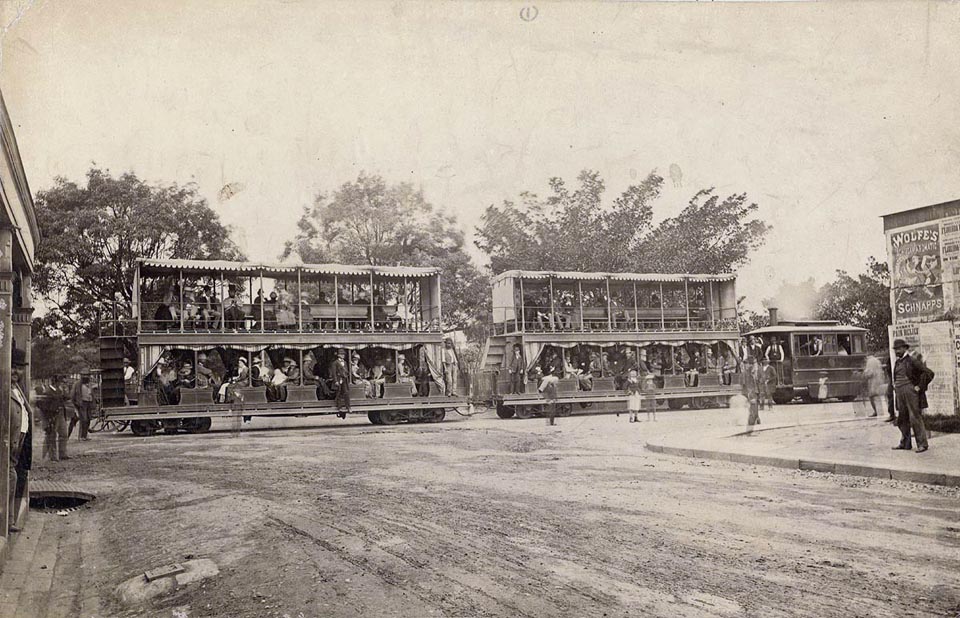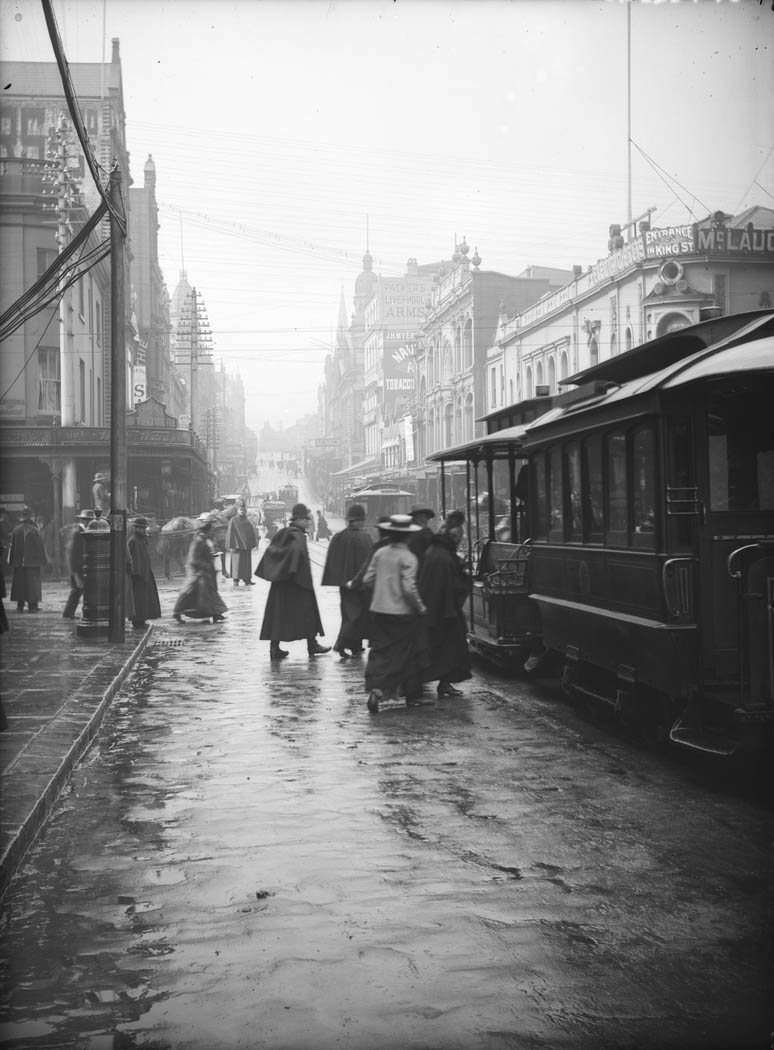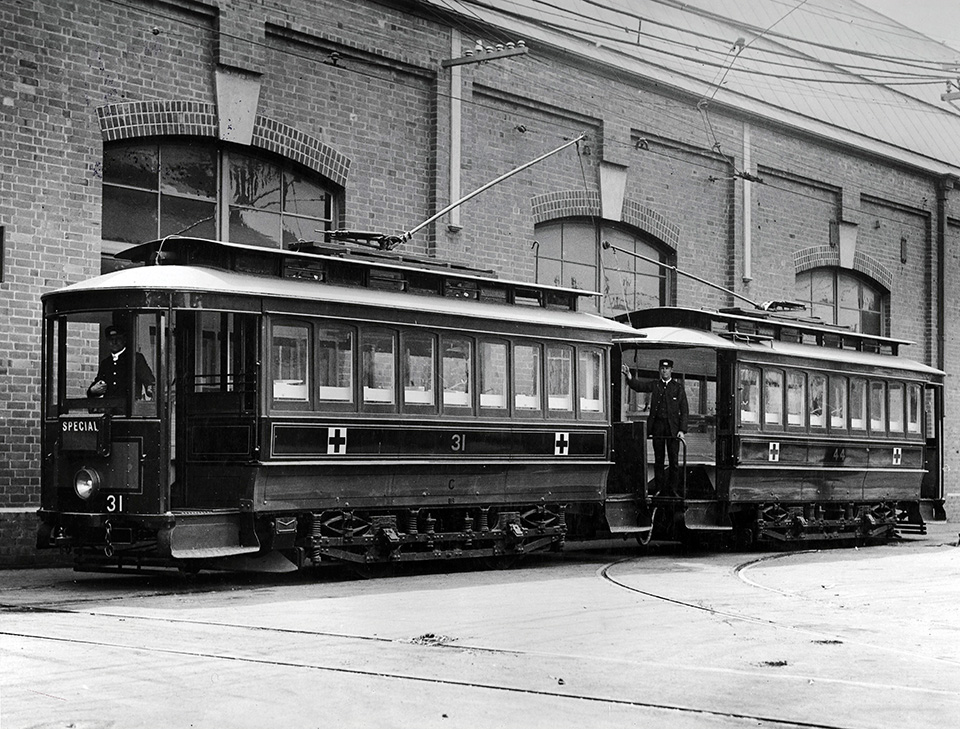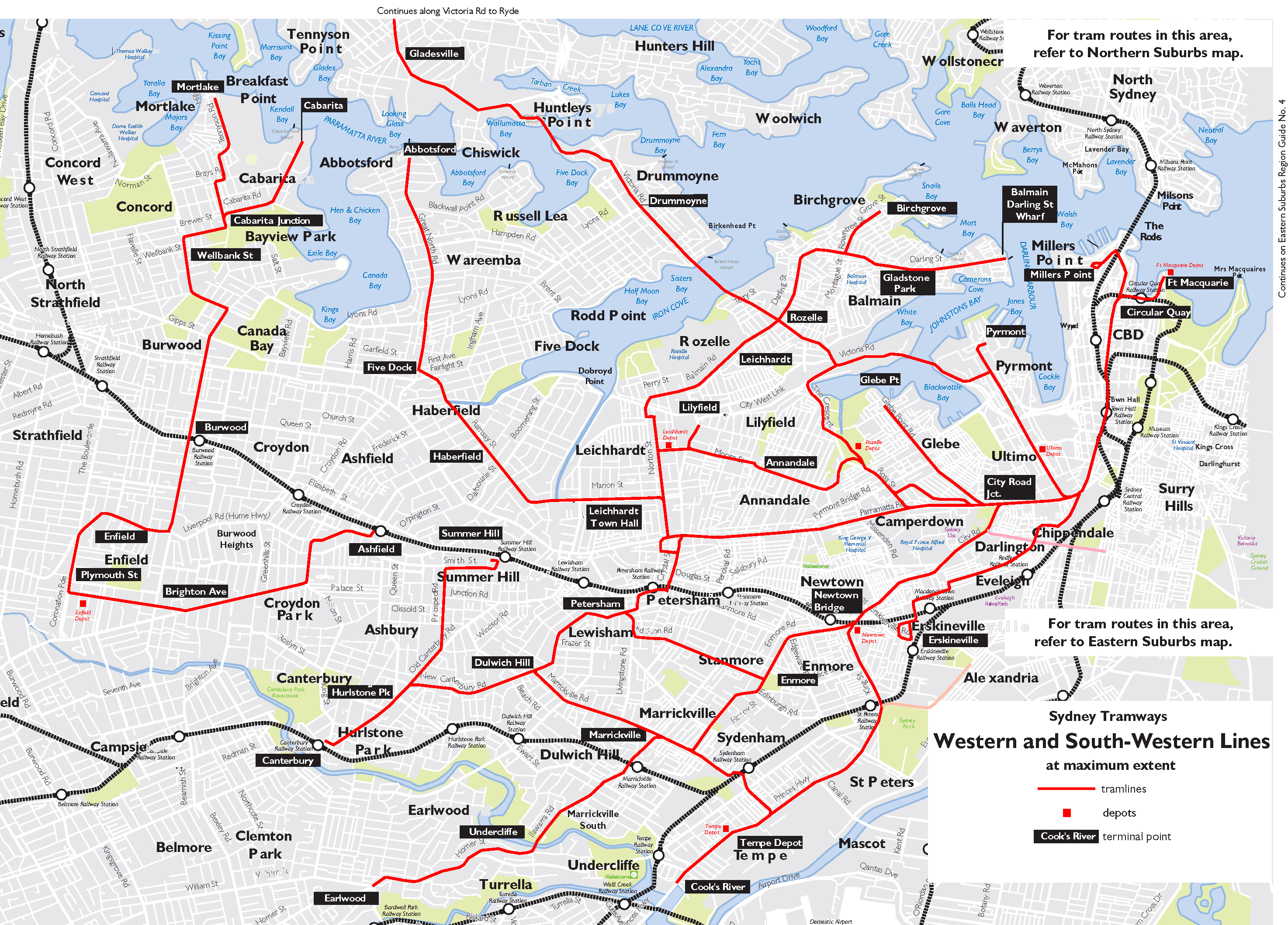The Dictionary of Sydney was archived in 2021.
Trams
Citation
Persistent URL for this entry
To cite this entry in text
To cite this entry in a Wikipedia footnote citation
To cite this entry as a Wikipedia External link
Trams
[media]As Sydney expanded geographically and demographically in the middle of the nineteenth century, particularly after the population influx associated with the gold rushes, the need for improved transport around the city became obvious. Late in 1859, a select committee of the New South Wales Legislative Assembly met to consider various options for this, and early the following year recommended that a tramway be constructed, running along Pitt Street between Circular Quay and the recently constructed railway terminus (then located at the Cleveland Paddocks, now Prince Alfred Park).
The first tramlines
[media]The line opened in December 1861, using horse-drawn trams. Initially the publicly owned line was run by the government, but it was later leased to private enterprise. It had its problems. Apart from cost overruns and poor revenue flows, the rails that had been imported from England were found to be unsuitable, and so had been laid upside down. This allowed the trams to run on them, but the protruding flanges were a major obstacle on the street, leading to many accidents and complaints.
Following these complaints and the death in a tram accident of the musician and teacher Isaac Nathan in 1864, another select committee in March 1866 recommended the removal of the tram system at the end of its lease in December 1866. [1] A horse-bus system filled the vacuum immediately.
In the 1870s there were various plans for new tram networks for the city, but nothing was done until the lead-up to the 1879 International Exhibition, to be held in the Garden Palace in the Botanic Gardens. With the exhibition looming, [media]a line from the railway terminus to Hunter Street via Elizabeth Street was constructed as a stop-gap measure. The public, remembering the Pitt Street debacle, were not enthusiastic, and it was agreed that the line would be dismantled after the exhibition was over.
[media]But the new tramway, powered by steam, was an immediate success. Nearly half a million passengers were conveyed, an average of more than 4,000 per day. Further, the return on the capital invested was high – around 33 per cent. In light of these successes, a bill authorising the government to construct tramways throughout the city and its suburbs was given assent in April 1880.
An era of growth
This [media]was the beginning of an era of rapid growth in the tramway network – from 2.5 kilometres in 1879 to almost 50 kilometres in 1884. It was, in many ways, a cheap alternative to a railway network, which required a far greater capital outlay. While the new steam trams were speedy and reliable, they also had environmental impacts, causing high levels of dust, noise and smoke in the city streets. Also, there were 'efficiency' concerns because of their marked limitations in traversing steep gradients.
[media]In 1884 a cable-driven tramway was first proposed for Sydney, from the ferry terminal at Milsons Point up to Ridge Street, North Sydney. The line was completed in May 1886. However, no sooner had this new technology been implemented than another even more revolutionary one appeared – electric power.
The introduction of the electric tram
By the late 1880s, technological innovation in the United States and Europe had produced three different systems of electrically powering a tramway – via a conduit, an 'accumulator' or with overhead wires.
[media]The first Sydney experiment was with an accumulator system, taking place at Botany Bay in June 1888. However, following further experiments, the accumulator method was abandoned. An experimental line using overhead wires was tested on the Waverley–Randwick extension in November 1890. Simultaneously, another cable tramway from King Street in the city to Ocean Street, Woollahra, was constructed. The tram era was in full swing.
Trams vs trains
Over [media]the next decade, new tramlines using the electric wire system were constructed around Sydney and its suburbs, expanding the network from 124 kilometres to more than 320. During this era there was increasing competition between trams and trains in the city's expanding west, but since both systems were publicly owned, any fall in revenue in one system resulted in a rise in revenue in the other. However, the ever-expanding size and population of Sydney meant that the newer suburbs were without tram services, while the services in the inner areas were increasingly congested.
[media]By 1922, the size of Sydney's tram network was at its peak. The Depression, followed by World War II, meant that a halt was called to further geographical spread. The war years also saw a much-publicised tram death, of the drag entertainer Lea Sonia, outside a club in Oxford Street, Woollahra, in 1942.
The decline of the tram
[media]After the war, several new developments had major impacts on Sydney's transport. The first was the decentralisation of industry, away from the inner city areas where it had been since the early days of the city, and away from the long-established rail or water transport networks. This was made possible by the growing use of motor vehicles, whether for industrial or private use. The introduction and spread of 'hire-purchase' allowed the city's population, expanding under the County of Cumberland Plan, to use cars to move into areas in outer Sydney poorly served by public transport.
The massive increase in the use of private cars, the perceived flexibility of buses over fixed-track trams and the cost advantage of not requiring dedicated track led to a growing debate about the future of the city's transport. Whereas in 1946–47 only 13 per cent of all trips in Sydney were by car, by 1960 this figure had risen to 50 per cent. This rapid increase in car use spelt doom for trams, as commuters deserted them in droves. By 1971, cars accounted for more than 70 per cent of trips in Sydney.
[media]In 1961, Sydney's last tram ran. Within days, road traffic congestion – due to the motor car – had begun.
While the general outline of Sydney's changing transport history is clear from public records and newspapers, historians of Sydney owe a lot to the tram buffs, whose obsessions with detail allow us to flesh out a tale that otherwise could not be fully told. David Keenan's books on the city's many and varied tram networks add depth and colour to our knowledge.
A transport crossroads
Today, amid concerns about the impact of carbon emissions, the end of oil as a major energy source and the clogging of the city's streets and freeways by motor vehicles, attention has turned once again to light rail tramways for the city. One such small system runs between Central Station and Lilyfield, with a possibility of extension. Transport experts and urban strategists alike are now urging Sydneysiders to abandon the car in favour of a less polluting and more socially equitable 'people-mover'. Sydney is, once again, at a transport crossroads.
References
David Keenan, Tramways of Sydney, Transit Press, Sydney, 1979
Brett Lennon and Garry Wotherspoon, 'Sydney's trams, 1861–1914: the rise of an urban mass transport system', in G Wotherspoon (ed), Sydney's Transport: Studies in Urban History, Hale & Iremonger in association with the Sydney History Group, Sydney, 1983
Sydney Tramway Museum, Sydney, www.sydneytramwaymuseum.com.au
David Keenan, Tramways of Sydney, Transit Press, Sydney, 1979
David Keenan, The South-Eastern Lines (of the Sydney Tramway System), Transit Press, Sydney, 1982
David Keenan, North Sydney Lines (of the Sydney Tramway System), Transit Press, Sydney, 1987
David Keenan, The Ryde Line (of the Sydney Tramway System), Transit Press, Sydney, 1988
David Keenan, The Eastern Lines (of the Sydney Tramway System), Transit Press, Sydney, 1989
David Keenan, The Watsons Bay Line (of the Sydney Tramway System), Transit Press, Sydney, 1990
David Keenan, City Lines (of the Sydney Tramway System), Transit Press, Sydney, 1991
David Keenan, The South-Western Lines (of the Sydney Tramway System), Transit Press, Sydney, 1992
David Keenan, The Western Lines (of the Sydney Tramway System), Transit Press, Sydney, 1993
David Keenan, The Rockdale and Enfield Lines (of the Sydney Tramway System), Transit Press, Sydney, 1994
David Keenan, The Manly Lines (of the Sydney Tramway System), Transit Press, Sydney, 1995
Notes
[1] The Sydney Morning Herald, 28 March 1866 p 5 http://nla.gov.au/nla.news-article13128753
.



